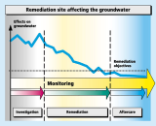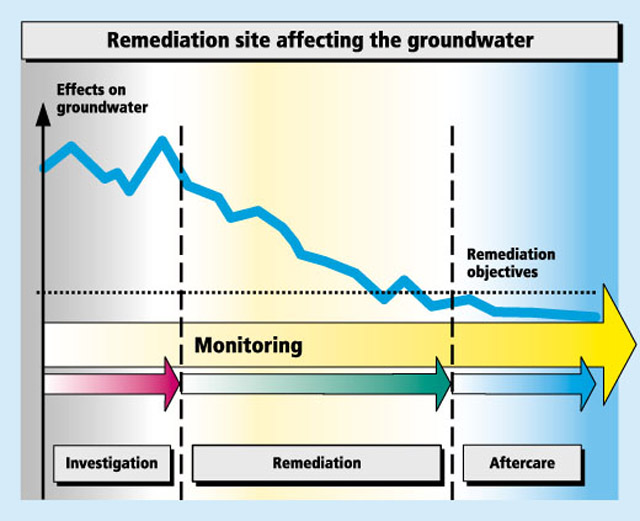Key elements of contaminated sites remediation
Monitoring
In order that potential polluted sites be responded to as rapidly and efficiently as possible, the Contaminated Sites Ordinance stipulates monitoring for sites in need of monitoring and remediation. Contaminated sites must be monitored until the conclusion of their remediation. A remediation is only concluded when the remediation objectives have been reached. Planning or establishing monitoring is a firm component of the remediation project.
The conclusion of the remediation is marked by assessing its results. Such an evaluation is primarily intended to determine whether the remediation measures were effective and the remediation objectives achieved.
Any necessary monitoring during the aftercare phase has to be done until the need for such monitoring in accordance with the Contaminated Sites Ordinance regulations no longer exists.
General monitoring objectives:
- to ensure correct reactions in the case of unforeseen events in order to prevent any further hazard to the environment.
- to enable changes in the impact of a site to be recognised in good time and possible developments to be forecast
- to reveal relevant data by:
- sample taking and analysis in accordance with an analysis programme adapted to the individual case or the remediation objectives.
- monitoring functions at sample sites such as shafts, pressure and level measuring instruments (piezometer) etc.
- to document results in a clearly understandable manner (reporting and archiving).

The individual monitoring phases during the contaminated site management; the development of the pollution level in the protected natural resource.
Aftercare
This step in remediation is adjunct to the remediation or the assessment of results. It is always required where a residual risk gives reason to suspect that the natural resources will continue to be endangered. This affects sites, for example, where the pollutants have not been removed but where their potential release paths were simply blocked by securing measures.
Monitoring during the aftercare phase is primarily intended to:
- ensure the long-term effectiveness of the remediation measures
- reveal the necessity of any measures to correct remaining defects
- monitor any possible release paths of the pollutants
- ensure the long-term operation of technical installations and buildings
Last modification 07.07.2021






